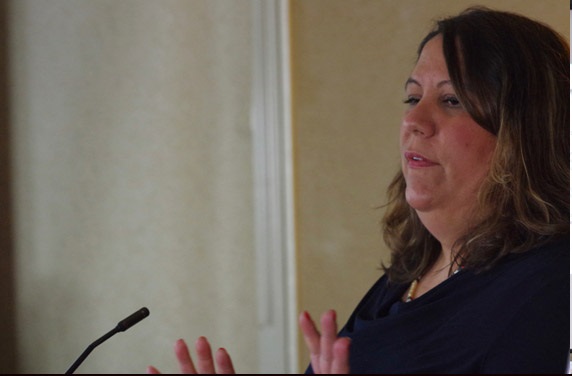Entrepreneurship session panelists explore how to navigate for potential funding opportunities

By Rick Garrick
THUNDER BAY—The Anishinabek Nation Entrepreneurship gathering’s Funding Panel Coffee Chat session provided participants with more knowledge about potential funding opportunities for themselves and other Indigenous people. The gathering was held on March 29 in Thunder Bay.
“The most important piece today is in recognition of coming together and building that capacity again to realize we’ve always been entrepreneurs,” says Michelle Richmond-Saravia, organizer of the gathering, owner of beSuperior Consulting and Biigtigong Nishnaabeg citizen. “However, one of our biggest barriers as I heard today is around funding opportunities. So how do we be innovative and how do we set those terms so that our businesses are actually moving ahead. So I think strategizing and building opportunities to network and meet and share ideas really helps. Today we had a really great lineup of speakers — they all touched on different aspects.”
The Funding Panel Coffee Chat session featured panelists from Nishnawbe Aski Development Fund (NADF), PARO Centre for Women’s Enterprise and Ontario Arts Council.
“Our mandate is to help Aboriginal business,” says Charlton Thompson, senior account manager at NADF and a Biinjitiwaabik Zaaging Anishinaabek citizen. “Our tagline, our actual vision right now is Aboriginal prosperity. We have five different programs on the go right now and they are all targeted to different areas.”
Thompson says NADF’s Financial Services program provides training on bookkeeping and financial statements.
“But they also have a grants program, which is an equity assistance grant up to $10, 000,” Thompson says. “If you have a project that fits under their criteria, 90 per cent of it could be grant and you would have to put in 10 per cent as equity into the project as well.”
Thompson says NADF’s service area extends from the Manitoba border to Fort Severn and the James Bay coast in the north to the Timmins-Cochrane area in the east to Wawa and Chapleau in the south.
Aleksa Sherman, from PARO Centre for Women’s Enterprise, says PARO’s programs help both men and women.
“The centre started as basically a way to create a peer lending program for women,” Sherman says. “We go all the way from the Manitoba border to Renfrew County, Arnprior, so around Ottawa. So it is a huge area that we travel. We have six regional growth advisors, so they are throughout the region travelling constantly plus us staff members from Thunder Bay are always out travelling throughout the region connecting with different entrepreneurs in all different communities.”
Sherman says PARO’s Peer Lending Circle is a program that is only for women.
“In Ontario now, I think we have 93 circles,” Sherman says. “A circle is a group of four-to-seven women.”
Alana Forslund, from the Ontario Arts Council, says her role is to support artists and organizations who want to learn about how to access OAC’s funding.
“OAC has over 50 funding programs,” Forslund says. “Part of my job is to help find the program that might fit best for your project ideas. We do support artists and makers.”
Forslund says OAC also provides support for First Nations that are looking to bring arts into their community.
The gathering also featured two visioning exercises on Challenges for youth, women, men, and Elders in Entrepreneurship and Best Practices and Successes for youth, women, men, and Elders in Entrepreneurship; two speakers from the Union of Ontario Indians; a presentation by Matawa First Nations Management mineral development information officer and Biigtigong Nishnaabeg citizen Peter Moses on opportunities in the mining industry; and a presentation on What is an Entrepreneur Warrior? by Richmond-Saravia.


